Health Monitoring Analysis of an Urban Rail Transit Switch Machine
Abstract
:1. Introduction
- (1)
- This paper takes the metro switch machine as the research object, collects the current data of the switch machine in normal and abnormal conditions, and summarizes four common abnormal operation current conditions based on the data of the rail transit industry;
- (2)
- This paper first analyzes the current data monitored by the microcomputer of switch machine equipment in Hangzhou Metro Line 10, and extracts the characteristics of abnormal current data. The current data of the switch machine of Metro Line 10 are input into the MLP model for pre-training, which acts as the Q-network of the DQN algorithm. It is responsible for estimating the expected reward of each state–action pair, guiding the strategy selection, and continuously learning and optimizing the weight of the MLP model through experience replay. By comparing this method with the MLP model method, it proves that the MLP-DQN method is efficient and superior in the fault diagnosis of switch machine equipment.
2. Literature Review
3. Data Processing
3.1. Action Current Curve
Normal Operation Current Curve
3.2. Abnormal Action Current Curve
4. Algorithmic Model
4.1. Building the MLP Model
4.2. Model Optimization
MLP-DQN Model
4.3. Health Degree Model of Switch Machine
5. Model Training
5.1. Experimental Environment
5.2. Experiment Setup
5.3. Evaluation Index
5.4. Experimental Result
5.4.1. Model Training Results
5.4.2. Switch Machine Health Results
6. Summary and Conclusions
- (1)
- This study discusses the conversion process from positioning to reverse positioning of the turnout system, elaborates the five key stages of the working mechanism of the S700K, and makes in-depth analysis. In view of the unique characteristics of abnormal current curves, this paper summarizes eight common abnormal current curves of switch machines, and further analyzes their potential reasons for abnormality;
- (2)
- In the feature processing stage, the feature parameters are extracted from the time domain and frequency domain, and the features of the abnormal current curve data are extracted using the MLP model. Based on the obtained data characteristics, the MLP-DQN model is tested. The experimental results show that the loss function values of the model on the training set and the verification set show a specific change trend during the training process. With the progress of training, the loss value of the model on the training set gradually decreases, showing the improvement of the model’s learning ability. The average accuracy of the model is 96.67% and the loss value is 0.1221 on the test dataset, which proves the high efficiency and accuracy of the MLP-DQN model in the state evaluation of the switch machine. The above analysis not only demonstrates the powerful performance of the MLP-DQN model in processing current signal data from the switch maneuver, but also reflects the key observations during feature extraction and model training. These findings provide important insights into how models behave on different datasets and provide a basis for further optimization of model structure and parameters.
- (3)
- On the establishment of the health degree model of the switch machine, the Fréchet distance is used to calculate the health status of the switch machine by combining the occurrence frequency of the abnormal switch machine’s current curve and the maintenance complexity.
Author Contributions
Funding
Institutional Review Board Statement
Informed Consent Statement
Data Availability Statement
Acknowledgments
Conflicts of Interest
References
- He, H.; Dai, M.; Li, X.; Tao, W. Research on Intelligent Fault Diagnosis Method of Turnout based on DCNN-SVM. J. Chin. Railw. Soc. 2023, 45, 103–113. [Google Scholar]
- Zhang, K.; Du, K.; Ju, Y. Algorithm of Railway Turnout Fault Detection Based on BP Neural Network. In Proceedings of the 2014 International Conference on Advanced Computer Science and Engineering (ACSE 2014), Hangzhou, China, 13–14 December 2014. [Google Scholar]
- Zhang, K.; Du, K.; Ju, Y. Fault Diagnosis Algorithm of Speeding Turnout Based on BP Neural Network. J. Wuhan Univ. Technol. 2014, 36, 77–81. [Google Scholar]
- Zhang, T. Research on Intelligent Analysis of Current Curve of S700K Rotary Machine. Manuf. Autom. 2014, 36, 71–74+77. [Google Scholar]
- Tang, W.H. Research on Feature Extraction and identification of Turnout Fault Based on LSTM/NN. Comput. Appl. Softw. 2019, 36, 159–163. [Google Scholar]
- Li, Z.Y. Abnormal data mining of ZDJ9 Point Machine based on improved DPC algorithm. Railw. Commun. Signal Eng. Technol. 2012, 19, 1–6. [Google Scholar]
- Zhang, H.; Wu, M. Cause analysis and remediation measures of foreign matter on sliding bed plate of subway turnout—A case study of W0108# reentry turnout of Hangzhou Metro Line 1. Ind. Technol. Innov. 2023, 10, 69–76. [Google Scholar]
- Wang, Z.; Zhang, Z.; Qin, J.; Ji, C. Review of Mechanical Fault Diagnosis Technology Based on Convolutional Neural Network. Comput. Appl. 2022, 42, 1036–1043. [Google Scholar]
- Xu, Q.; Liu, Z.; Zhao, H. Bifurcation Fault Diagnosis Method Based on Hidden Markov Model. J. Railw. Sci. 2018, 40, 98–106. [Google Scholar]
- Cui, Y.; Wang, H.; Zhang, S.; Wang, X. Gas Turbine Rotor Fault Diagnosis Method Based on Improved DQN. Noise Vib. Control. 2023, 43, 109–115+199. [Google Scholar]
- Lu, Y. Rolling Bearing Fault Diagnosis Method Based on Multi-layer Perceptron and Proximal Strategy Optimization. Bearing, 1–8. Available online: http://kns.cnki.net/kcms/detail/41.1148.TH.20221230.1410.003.html (accessed on 23 December 2023).
- Meng, L.; Zheng, L.; Zheng, Z.; Liu, R. Based on the Whale MLP Algorithm Optimization of Rolling Bearing Fault Diagnosis. Bearing, 1–10. Available online: http://kns.cnki.net/kcms/detail/41.1148.TH.20230627.1618.006.html (accessed on 23 December 2023).
- Long, J. Rotating machinery fault diagnosis strategy based on depth of intensive study. J. Mech. Des. Manuf. 2021, 10, 7. [Google Scholar] [CrossRef]
- Ma, L. Reinforcement Learning Based on the Depth of Communication Anti-Jamming Technology Research. Master’s Thesis, Nanjing University of Posts and Telecommunications, Nanjing, China, 2023. [Google Scholar]
- Li, F.; Wang, H.; Lu, Z.; Wang, Z. Real-Time Optimal Scheduling of AC/DC Hybrid Microgrid Based on Artificial Auxiliary Deep Reinforcement Learning. Mod. Electr. Power 2023, 40, 577–586. [Google Scholar] [CrossRef]
- Zhang, D.; Li, G. Fault Diagnosis of S700K Switch Machine Based on Improved WNN analysis Power Curve. J. Railw. Sci. Eng. 2018, 15, 2123–2130. (In Chinese) [Google Scholar] [CrossRef]
- Wei, W.; Liu, X.; Zhang, M. Fault Diagnosis of S700K Switch Machine based on EEMD Multi-scale Fuzzy entropy. J. Railw. Sci. 2022, 44, 60–66. [Google Scholar]
- Li, L. Switch Based on Convolutional Neural Network Fault Diagnosis Method Research. Master’s Thesis, Lanzhou Jiaotong University, Lanzhou, China, 2019. [Google Scholar]
- Chen, Q.; Nicholson, G.; Ye, J.; Roberts, C. Fault Diagnosis Using Discrete Wavelet Transform (DWT) and Artificial Neural Network (ANN) for A Railway Switch. In Proceedings of the 2020 Prognostics and Health Management Conference (PHM-Besançon), Besancon, France, 4–7 May 2020. [Google Scholar]
- Zhou, F.; Xia, L.; Dong, W.; Sun, X.; Yan, X.; Zhao, Q. Fault diagnosis of high-speed railway turnout based on support vector machine. In Proceedings of the 2016 IEEE International Conference on Industrial Technology (ICIT), Taipei, Taiwan, 14–17 March 2016. [Google Scholar] [CrossRef]
- Zhang, K. The railway turnout fault diagnosis algorithm based on BP neural network. In Proceedings of the 2014 IEEE International Conference on Control Science and Systems Engineering, Yantai, China, 29–30 December 2014. [Google Scholar]
- Cheng, Y.; Zhao, H. Fault detection and diagnosis for railway switching points using fuzzy neural network. In Proceedings of the 2015 IEEE 10th Conference on Industrial Electronics and Applications (ICIEA), Auckland, New Zealand, 15–17 June 2015; pp. 860–865. [Google Scholar] [CrossRef]
- De Bruin, T.; Verbert, K.; Babuška, R. Railway Track Circuit Fault Diagnosis Using Recurrent Neural Networks. IEEE Trans. Neural Netw. Learn. Syst. 2016, 28, 523–533. [Google Scholar] [CrossRef] [PubMed]
- Huang, S.; Yang, L.; Zhang, F.; Chen, W.; Wu, Z. Turnout Fault Diagnosis Based on CNNs with Self-Generated Samples. J. Transp. Eng. Part A Syst. 2020, 146, 04020105. [Google Scholar] [CrossRef]
- Patel, R.A.; Bhalja, B.R. Condition monitoring and fault diagnosis of induction motor using support vector machine. Electr. Power Compon. Syst. 2016, 44, 683–692. [Google Scholar] [CrossRef]
- Zhang, R.; Zhao, H.; Hou, L.; Chen, F.; Shao, Z.; Ji, W.; Cai, B. Fault diagnosis method of offshore cementing pump based on MLP neural network. Autom. Instrum. 2022, 9, 54–57. [Google Scholar] [CrossRef]
- Kang, H.; Wu, Y.; Chen, L.; Zhang, X. Research on Device Modeling Technique Based on MLP Neural Network for Model Parameter Extraction. Appl. Sci. 2022, 12, 1357. [Google Scholar] [CrossRef]
- Wu, W.; Chen, J.; Liu, X.; Zhou, Z. Intelligent fault diagnosis method based on unsupervised feature representation Deep Q Learning. J. Cent. South Univ. 2022, 53, 1750–1759. [Google Scholar]
- Zhu, Z.; Zhang, X.; Chen, H. Voltage Control Method of Distribution Network with Intelligent Soft Switch Based on Deep reinforcement Learning. High Volt. Technol. 2024, 50. [Google Scholar] [CrossRef]
- Zhou, J. Rotating Machinery Fault Diagnosis Method Based on the Depth of Reinforcement Learning Research. Master’s Thesis, Chongqing Jiaotong University, Chongqing, China, 2020. [Google Scholar]
- Huang, Z. Hyperparameter Optimization Method Based on Improved DQN Algorithm and Its Application in Fault Diagnosis. Master’s Thesis, Huazhong University of Science and Technology, Wuhan, China, 2021. [Google Scholar]
- Li, F. Interturn Short Circuit Fault Diagnosis of Permanent Magnet Synchronous Motor Based on Deep Reinforcement Learning. Master’s Thesis, Jiangsu University of Science and Technology, Zhenjiang, China, 2022. [Google Scholar]



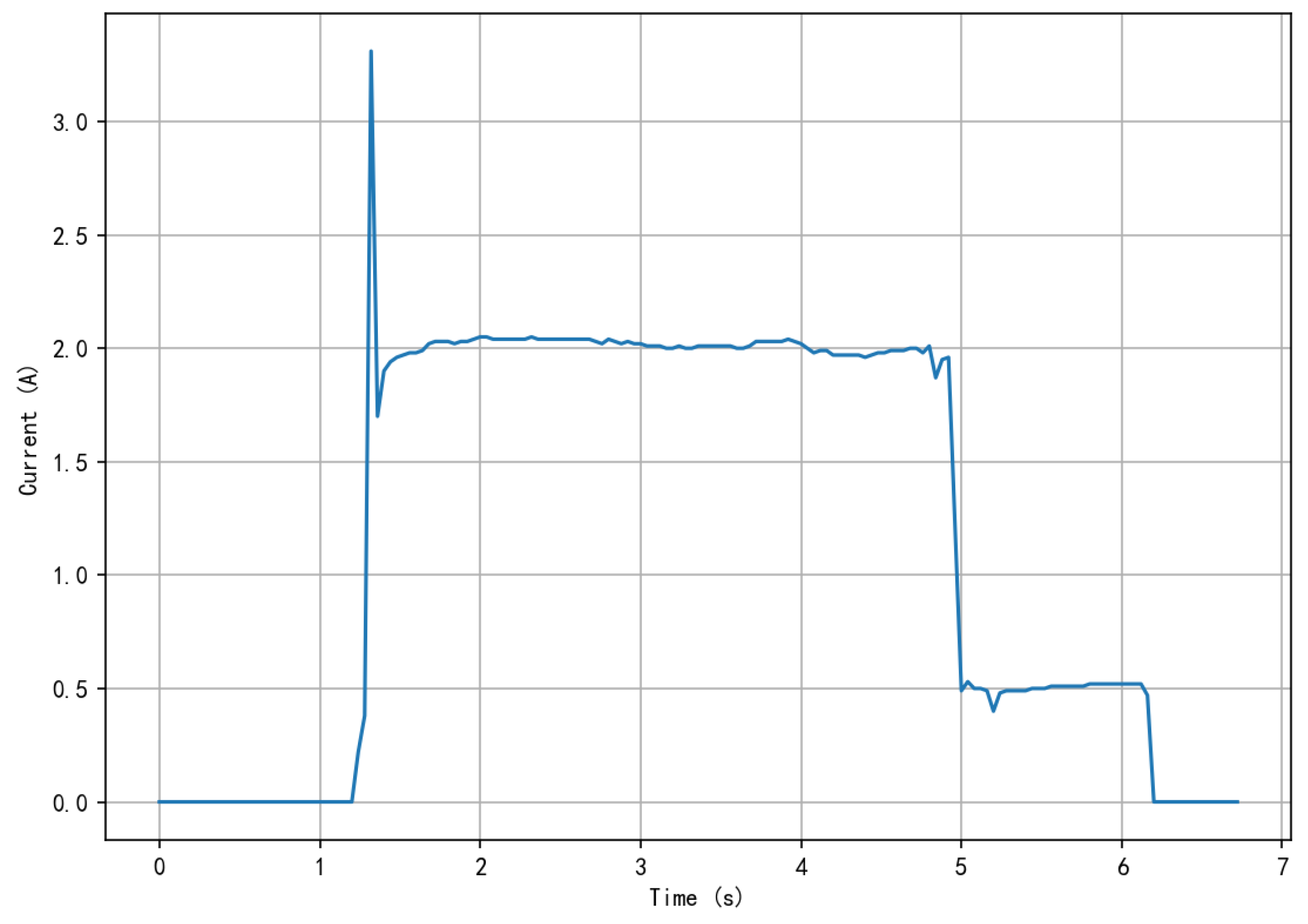



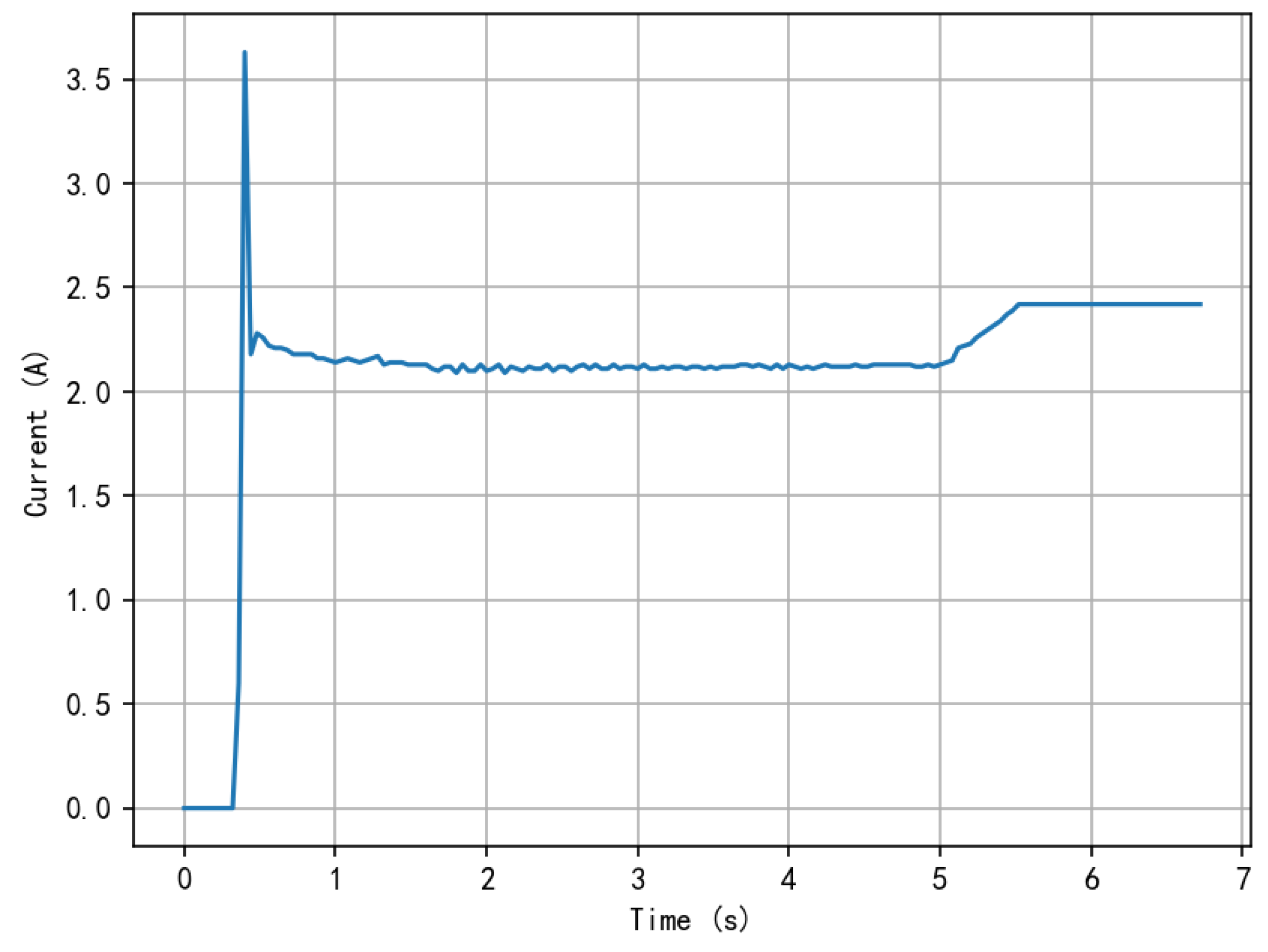
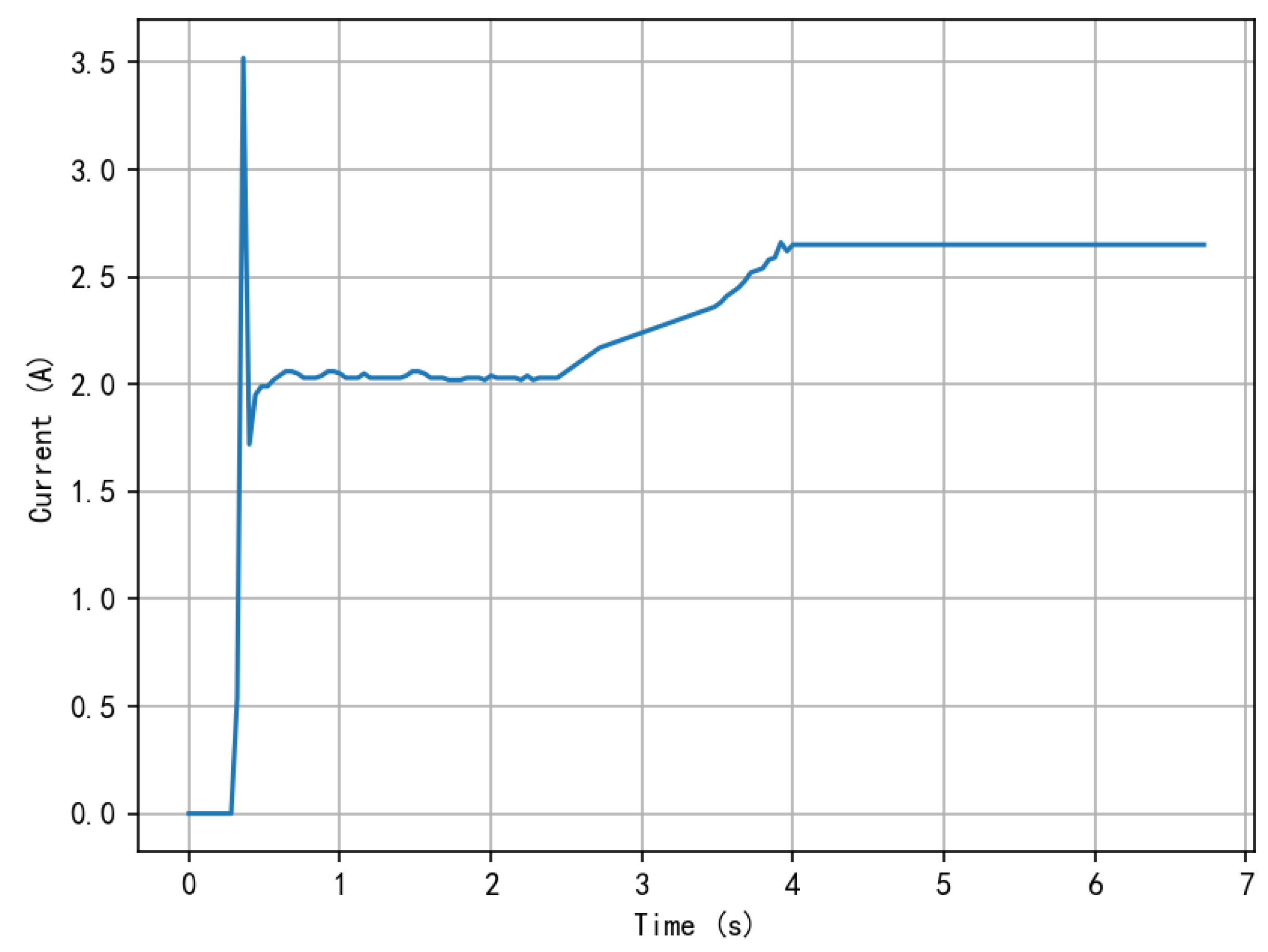
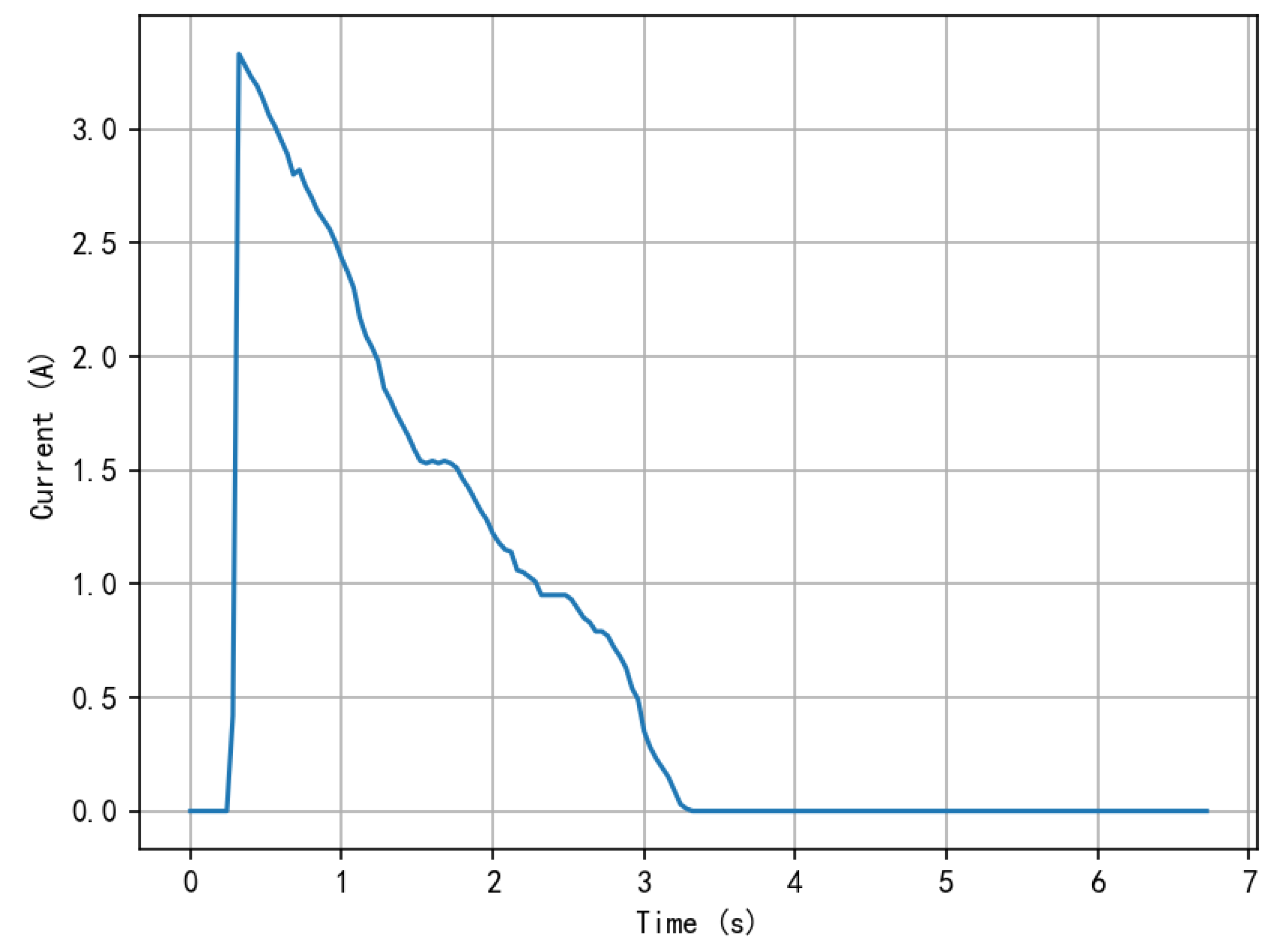
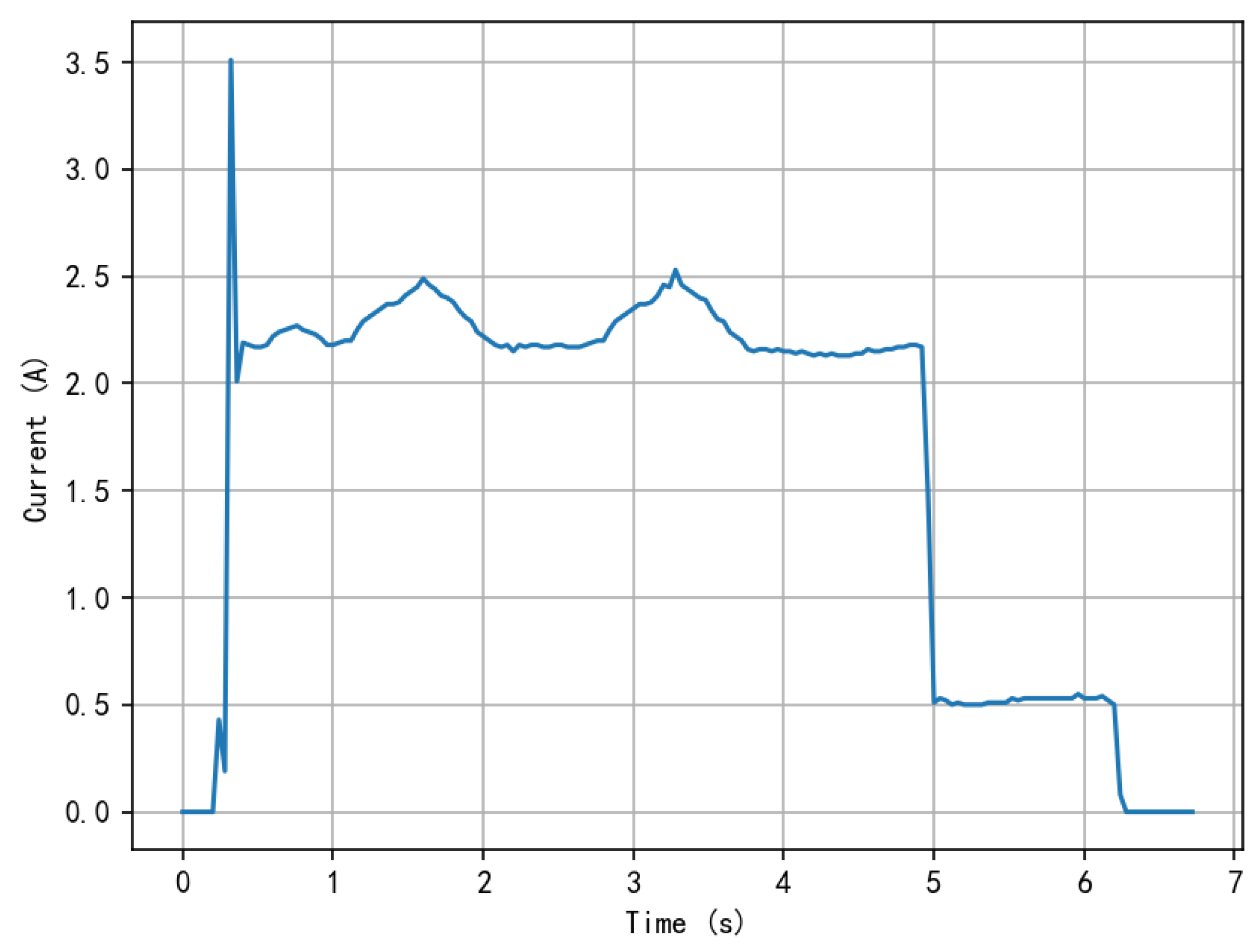

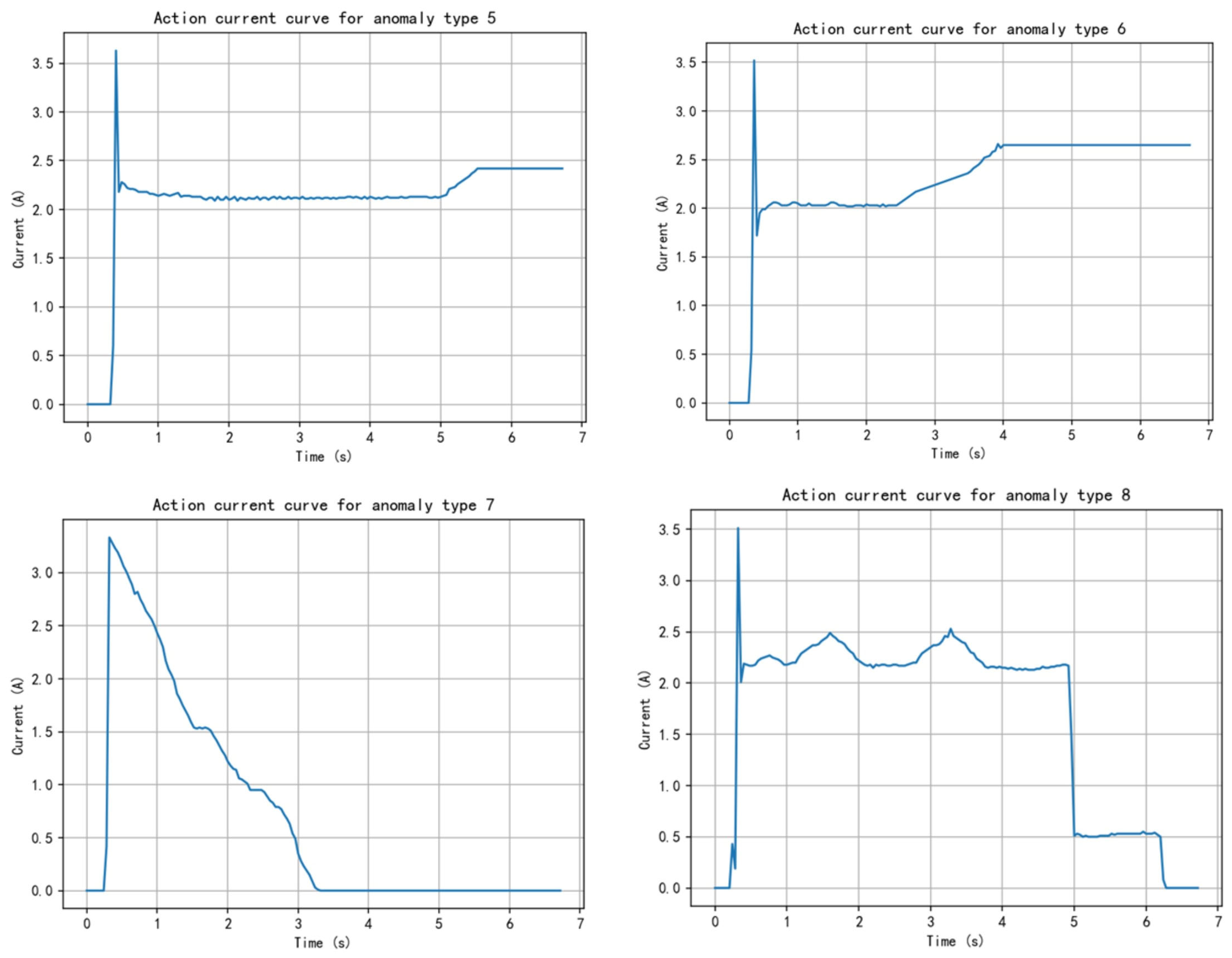


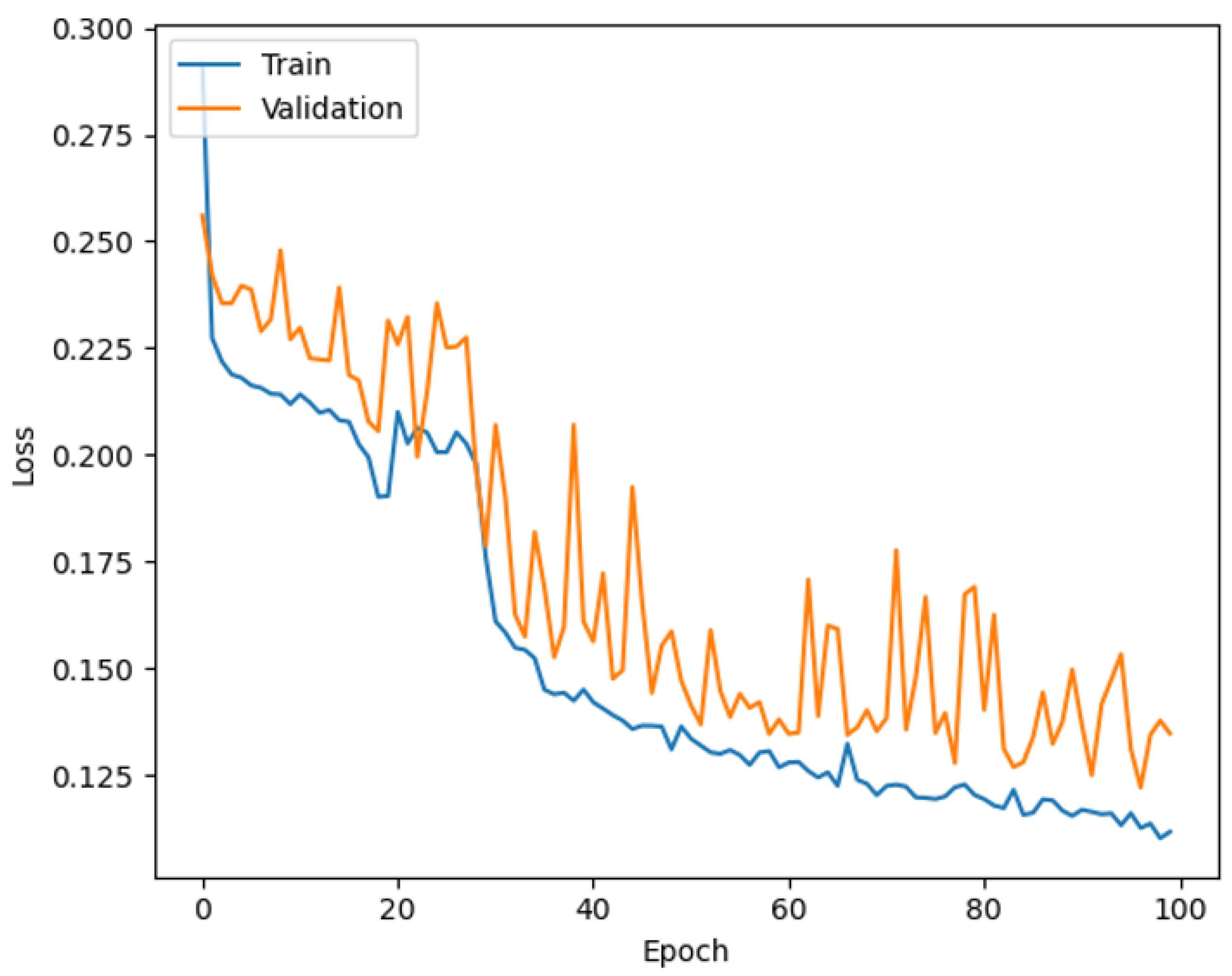
| Types of Exceptions | Abnormal Phenomenon | Cause of Exception |
|---|---|---|
| Figure 1 | normal | none |
| Figure 4 | Delay in the start of the turnout | A relay contact in the switch-on circuit |
| Figure 5 | Switch machine encounters a gap obstruction | Fault or wear in the switch mechanism of the turnout |
| Figure 6 | No coasting phase action current | Open circuit in the outdoor rectifier stack |
| Figure 7 | Surge in coasting phase action current | Diode breakdown short circuit |
| Figure 8 | Switch not interlocked | Inflexible operation of automatic circuit breaker |
| Figure 9 | Switch obstruction | Internal obstruction in the gearbox, foreign object on the pointed rail, etc. |
| Figure 10 | Switch sudden stop after activation | 1DQJ malfunction or open circuit in the starting circuit |
| Figure 11 | Unstable action current | Poor cleaning of the converter or sliding bed |
| Layer | Type | Input Shape | Output Shape | Parameters |
|---|---|---|---|---|
| Input | - | None,169 | None,169 | 0 |
| Hidden1 | Dense | None,169 | None,24 | 4080 |
| Dropout1 | Dropout | - | None,24 | 0 |
| Hidden2 | Dense | - | None,24 | 600 |
| Dropout2 | Dropout | - | None,24 | 0 |
| Output | Dense | None,24 | None,8 | 200 |
| Exception Types | Number of Curves C | (C/T) × 100% | Repair Complexity R |
|---|---|---|---|
| 1 | 581 | 19.40547762 | 6.2 |
| 2 | 90 | 3.006012024 | 6.0 |
| 3 | 1968 | 65.73146293 | 9.1 |
| 4 | 355 | 11.85704743 | 8.5 |
| Total | 2994 | 100% | - |
| Equipment | Model and Parameters |
|---|---|
| Processor | Intel Core i7-13700H |
| Memory | 16 GB |
| Hard disk | 1 T SSD |
| GPU model | NVIDIA GeForce RTX 4060 |
| GPU memory | 8 G |
| Environment Construction | |
|---|---|
| Compiled language | Python3.8 |
| Learning framework | TensorFlow2.10.0 |
| Operating system | Windows11 |
| Parameters | Numerical (set) |
|---|---|
| Loss function | Categorical cross entropy |
| Optimizer | Adam |
| Learning rate | 0.001 |
| Discount rate | 0.95 |
| Decay rate | 0.995 |
| Epoch | 100 |
| Batch size | 64 |
| State size | 169 |
| Number of neurons in Hidden Layer 1 | 24 |
| Number of neurons in Hidden Layer 2 | 24 |
| Experience replay batch size | 16 |
| Type | Number | Curve | Y |
|---|---|---|---|
| 84-A | 169 | 0.00,0.00,… | 1 |
| 84-A | 169 | 0.00,0.00,… | 1 |
| 38-A | 169 | 0.00,0.00,… | 1 |
| 74-A | 169 | 0.00,0.00,… | 1 |
| 74-A | 169 | 0.00,0.00,… | 1 |
| 66-A | 169 | 0.00,0.00,… | 1 |
| 66-A | 169 | 0.00,0.00,… | 1 |
| 76-A | 169 | 0.00,0.00,… | 1 |
| 76-A | 169 | 0.00,0.00,… | 1 |
| 20-A | 169 | 0.00,0.00,… | 1 |
| 20-A | 169 | 0.00,0.00,… | 1 |
| Type | Number | Curve | Predicted_Y |
|---|---|---|---|
| 84-A | 169 | 0.00,0.00,… | 1 |
| 84-A | 169 | 0.00,0.00,… | 1 |
| 38-A | 169 | 0.00,0.00,… | 1 |
| 74-A | 169 | 0.00,0.00,… | 1 |
| 74-A | 169 | 0.00,0.00,… | 1 |
| 66-A | 169 | 0.00,0.00,… | 1 |
| 66-A | 169 | 0.00,0.00,… | 1 |
| 76-A | 169 | 0.00,0.00,… | 1 |
| 76-A | 169 | 0.00,0.00,… | 1 |
| 20-A | 169 | 0.00,0.00,… | 1 |
| 20-A | 169 | 0.00,0.00,… | 1 |
| Type | Number | Curve | Y | Health |
|---|---|---|---|---|
| 84-A | 169 | 0.00,0.00,… | 1 | 0.8481 |
| 2-A | 169 | 0.00,0.00,… | 1 | 0.3306 |
| 74-A | 169 | 0.00,0.00,… | 1 | 0.5894 |
| 68-A | 169 | 0.00,0.00,… | 2 | 0.1113 |
| 58-A | 169 | 0.00,0.00,… | 2 | 0.1225 |
| 24-A | 169 | 0.00,0.00,… | 2 | 0.0802 |
| 64-A | 169 | 0.00,0.00,… | 3 | 3.5787 |
| 42-A | 169 | 0.00,0.00,… | 3 | 3.2135 |
| 30-A | 169 | 0.00,0.00,… | 3 | 3.7248 |
| 66-A | 169 | 0.00,0.00,… | 4 | 0.6792 |
| 66-A | 169 | 0.00,0.00,… | 4 | 0.3982 |
| 42-A | 169 | 0.00,0.00,… | 4 | 0.4333 |
| Exception Types | |
|---|---|
| 1 | 0.5516 |
| 2 | 0.1063 |
| 3 | 3.5671 |
| 4 | 0.4395 |
| Notations and Acronyms | Full Name |
|---|---|
| 1DQJ | Switch Start Relay 1 |
| 2DQJ | Switch Start Relay 2 |
| MLP | Multi-layer perceptron |
| DQN | Deep Q-network |
| AC | Alternating current |
| S700K | Model S700K switch machine |
| ReLU | Rectified linear unit |
Disclaimer/Publisher’s Note: The statements, opinions and data contained in all publications are solely those of the individual author(s) and contributor(s) and not of MDPI and/or the editor(s). MDPI and/or the editor(s) disclaim responsibility for any injury to people or property resulting from any ideas, methods, instructions or products referred to in the content. |
© 2024 by the authors. Licensee MDPI, Basel, Switzerland. This article is an open access article distributed under the terms and conditions of the Creative Commons Attribution (CC BY) license (https://creativecommons.org/licenses/by/4.0/).
Share and Cite
Wang, Z.; Sun, D.; Zhou, J.; Guo, K.; Zhang, J.; Kou, X. Health Monitoring Analysis of an Urban Rail Transit Switch Machine. Sustainability 2024, 16, 3527. https://doi.org/10.3390/su16093527
Wang Z, Sun D, Zhou J, Guo K, Zhang J, Kou X. Health Monitoring Analysis of an Urban Rail Transit Switch Machine. Sustainability. 2024; 16(9):3527. https://doi.org/10.3390/su16093527
Chicago/Turabian StyleWang, Zishuo, Di Sun, Jin Zhou, Kaige Guo, Jiaxin Zhang, and Xiangyu Kou. 2024. "Health Monitoring Analysis of an Urban Rail Transit Switch Machine" Sustainability 16, no. 9: 3527. https://doi.org/10.3390/su16093527




